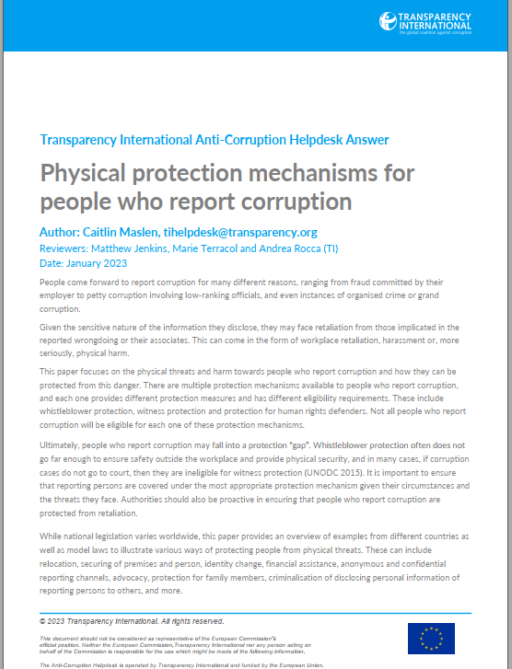
This Anti-Corruption Helpdesk brief was produced in response to a query from one of Transparency International’s national chapters. The Anti-Corruption Helpdesk is operated by Transparency International and funded by the European Union.
Query
Please provide an overview of protective measures available for people who report corruption that ensure their physical safety after a disclosure has been made. Are there any examples of these protections, how are they implemented and what do they involve?
Summary
People come forward to report corruption for many different reasons, ranging from fraud committed by their employer to petty corruption involving low-ranking officials, and even instances of organised crime or grand corruption.
Given the sensitive nature of the information they disclose, they may face retaliation from those implicated in the reported wrongdoing or their associates. This can come in the form of workplace retaliation, harassment or, more seriously, physical harm.
This paper focuses on the physical threats and harm towards people who report corruption and how they can be protected from this danger. There are multiple protection mechanisms available to people who report corruption, and each one provides different protection measures and has different eligibility requirements. These include whistleblower protection, witness protection and protection for human rights defenders. Not all people who report corruption will be eligible for each one of these protection mechanisms.
Ultimately, people who report corruption may fall into a protection “gap” (UNODC 2015). Whistleblower protection often does not go far enough to ensure safety outside the workplace and provide physical security, and in many cases, if corruption cases do not go to court, then they are ineligible for witness protection (UNODC 2015). It is important to ensure that reporting persons are covered under the most appropriate protection mechanism given their circumstances and the threats they face. Authorities should also be proactive in ensuring that people who report corruption are protected from retaliation.
While national legislation varies worldwide, this paper provides an overview of examples from different countries as well as model laws to illustrate various ways of protecting people from physical threats. These can include relocation, securing of premises and person, identity change, financial assistance, anonymous and confidential reporting channels, advocacy, protection for family members, criminalisation of disclosing personal information of reporting persons to others, and more.
Contents
- Background
- Protection mechanisms
a. Whistleblower protection
b. Witness protection
c. Protection for human rights defenders - Protective measures
a. Anonymity and confidentiality
b. Advocacy
c. Digital security
d. Securing premises
e. Relocation
f. Changing identity - References
Authors
Caitlin Maslen (TI) [email protected]
Reviewers
Matthew Jenkins, Marie Terracol and Andrea Rocca (TI)
Date
25/01/2023

